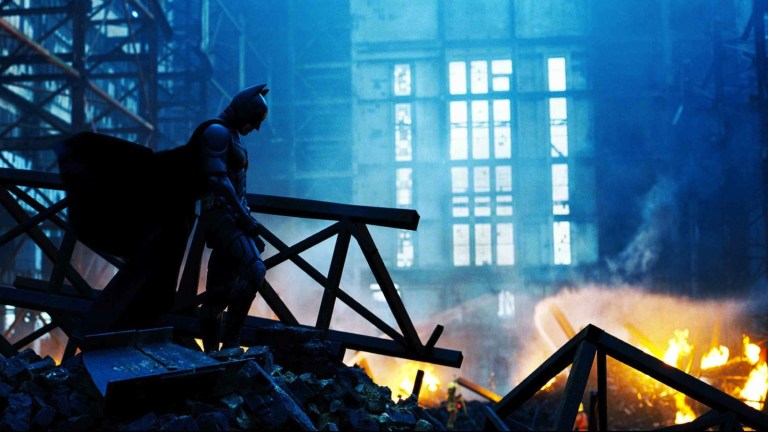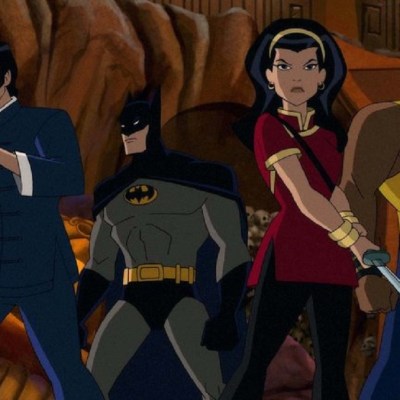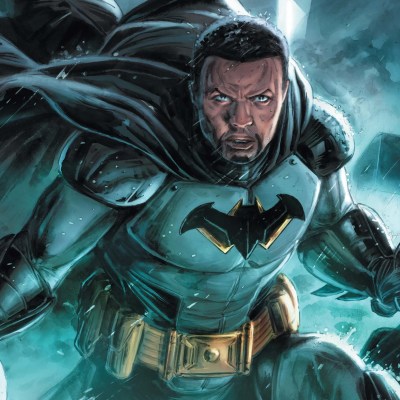How The Dark Knight’s Canceled Game Accidentally Changed Gaming
The Dark Knight video game may have been canceled, but we're still feeling its strange influence to this day.

The canceled video game adaptation of The Dark Knight is one of the more fascinating and infamous pieces of game industry lore. To some, the title is just a curious footnote in video game history. To others (mostly those who invested in the project or lost their jobs over it), it’s a dark reminder of an idea that is perhaps best left forgotten.
I see the game a little differently, though. While it’s easy to look at these kinds of projects that were never released and wonder what could have been, the fascinating thing about the canceled Dark Knight game is that wondering what would have happened if the game had been released is the quickest way to distract yourself from the many ways that the world of gaming was changed by the fact it wasn’t released.
Those who worked on The Dark Knight never got to properly share their efforts with the world, but that doesn’t mean that the canceled adaptation didn’t (perhaps unintentionally) help change gaming forever.
The Dark Knight Was Too Ambitious For its Own Good
While it’s rarely ever talked about today, 2005’s Batman Begins (a video game adaptation of the film of the same name) caught a lot of people by surprise. It wasn’t great, but it was a simple and solid action game that allowed people to easily play out the major events of the movie they had suddenly become enamored with. So far as that goes, it didn’t hurt that the adaptation featured the voices and likeness of many of the film’s actors.
Inspired by that game’s success, Elevation Partners later acquired the rights for a video game based on Christopher Nolan’s just green-lit Batman Begins sequel, The Dark Knight. EA would once again publish the adaptation, but this time, development duties were given to Pandemic Studios: the team best known at that time for their work on Star Wars: Battlefront and Mercenaries.
Everything that we know about the early days of The Dark Knight‘s development (much of which comes from this 2016 report on the project) suggests that it was initially intended to be a fairly straightforward follow-up to the Batman Begins game. That is to say that it was going to be a linear action/adventure game with stealth elements and a plot based on the film.
However, things changed drastically when the Brisbane branch of Pandemic that was working on The Dark Knight decided to use the open-world game engine (Odin) that the Los Angeles division of the company had developed for The Saboteur. Inspired by what they saw, the Brisbane team decided to convert The Dark Knight into an open-world game that they felt better represented the scope and spirit of Nolan’s films as well as some of the studio’s own work on previous hit open-world titles.
This is where things got really interesting. During the project’s conversion to an open-world title, Pandemic’s Brisbane team focused on more ambitious gameplay concepts that wouldn’t have been possible (or at least as interesting) in a linear setting. For instance, the team intended to allow players to navigate Gotham City by foot, by grappling hook, and via vehicles that included the Batmobile. These transportation options could be accessed at will and would make it easier for the player to complete the various side quests that the team intended to populate the world with.
It wasn’t just open-world innovations that increased the scope of Pandemic’s design efforts. For example, it’s been reported that Pandemic intended to emphasize the stealth elements that Batman Begins featured in a relatively limited capacity. The idea of an open-world game that emphasized stealth gameplay was something of a rare beast at that time, but it all supported that grander idea of making a game that felt true to the Nolan version of the character as well as classic Batman concepts.
That level of ambition is always appreciated, but Pandemic quickly discovered that the Odin engine was woefully ill-equipped to handle what they were working on. Even after they got the engine to simply load the assets without crashing, the team was unable to solve the truly terrible frame rates that made the game essentially unplayable throughout large chunks of the development process. It soon became clear that using this engine to create the open-world game that Pandemic had in mind was going to take a long time if it was going to work at all.
Unfortunately, time is the last thing the team had. In fact, it was time that ultimately killed the game.
The Dark Knight’s Biggest Problem May Have Been the Film It Was Based On
It’s actually kind of funny that Pandemic was so determined to do justice to Christopher Nolan’s The Dark Knight considering that they had very little input from anyone associated with the film throughout the early days of the game’s development.
The earliest versions of The Dark Knight game used placeholder assets built to run on PS2 technology. Both the outdated technology and the use of temporary assets largely unrelated to the upcoming film were something of a necessity as the team knew virtually nothing about the movie during the early days of development. It’s even been reported that some of the early looks they did receive (such as the design of The Joker), would later be changed as the production of The Dark Knight movie evolved. Art and test footage of the project suggests they eventually got a pretty good look at the final film, but that seems to have happened somewhere around the time that the title’s technical problems emerged.
The biggest burden The Dark Knight film put on Pandemic, though, was the movie’s July 2008 release date. Just as they had done with Batman Begins, EA was determined to have The Dark Knight game released alongside the film. However, it became increasingly clear that the game’s technical issues could not be resolved by that rapidly approaching deadline.
While it was decided that the team could instead release the game in December just as The Dark Knight debuted on DVD and Blu-Ray, that plan was shockingly derailed when Gary Oldman talked to G4 about what he had seen of the project. Seemingly unaware that the game was supposed to be kept a secret, Oldman got everyone asking questions about a title that was still plagued with technical problems and unlikely to make even the extended release window that EA had opened for Pandemic.
The project officially came to an end in October 2008 when EA decided to shut it all down over a lack of substantial progress and increased scrutiny. Some of those who remained at Pandemic’s Brisbane studio throughout the course of the troubled development process were offered the chance to go to the L.A. offices and work on The Saboteur. However, that lifeboat didn’t stay afloat for long as Pandemic was shut down entirely in 2009. It’s estimated that EA lost about $100 million in revenue by not releasing The Dark Knight and having to eat the project’s development costs.
Considering that some close to The Dark Knight game have stated that the project’s problems were slowly being resolved by the end of 2008, it’s possible that the game may have eventually been released were it not so closely tied to the movie in terms of its design, story, and publicity. At the very least, EA may have eventually figured that it was better to eventually release something rather than just cancel the game and eat all the losses.
The cancelation of The Dark Knight game should also spell the end of its story, influence, and legacy. However, that’s not what happened. Actually, The Dark Knight lived on in several remarkable ways.
The Fallout of The Dark Knight’s Cancelation Includes The Saboteur, Arkham Asylum, and Shadow of Mordor
While none of us have ever actually played The Dark Knight, there are a few games that followed which some feel offer a glimpse at the project’s bigger ideas.
The first was The Saboteur. While that project was in development during much of The Dark Knight‘s own development cycle (and was thus not necessarily directly influenced by the “fallout” of its cancelation), the parallels between the projects are fascinating. Besides obviously featuring a version of the same engine, The Saboteur also featured open environments, stealth sequences, vehicles, and an emphasis on moody urban settings. It’s hardly “Batman without Batman,” but it’s hard to look at that game and not see a few hints at what The Dark Knight could have been.
Middle-Earth: Shadow of Mordor is quite possibly the biggest game that was strangely influenced by The Dark Knight‘s cancelation. The story goes that Monolith Productions hoped to create a game based on Christopher Nolan’s The Dark Knight Rises or a Batman game designed to be released close to that movie’s debut. In fact, they reportedly started to work on such a project before they even had the official rights to the movie.
Unfortunately, those rights never came. There’s some debate about this part of the story, but it sounds like the biggest problem was that Nolan never signed off on the adaptation. Some suspect his hesitancy was due to his dissatisfaction with The Dark Knight‘s cancelation and perhaps his skepticism regarding the very idea of these quick-hit video game adaptations.
Not all was lost, though. Monolith reportedly decided to take their early work on that Batman game and transfer it to a title based on The Lord of the Rings. There’s some debate regarding how closely Shadow of Mordor resembles the early Dark Knight Rises project, but it’s believed that the former’s famous Nemesis system may have been based on an idea that the team would have used to generate thugs in Gotham City. It’s even been said that early versions of Shadow of Mordor featured a Batman character model in place of the eventual protagonist.
Of course, it’s impossible to talk about The Dark Knight without talking about Arkham Asylum. Considering that Arkham Asylum was announced in 2008 during the final days of The Dark Knight‘s development, it’s unlikely that developer Rocksteady Studios was heavily inspired by that project. That said, the similarities are hard to ignore. Both featured an emphasis on stealth gameplay, both were larger and more ambitious than many of the Batman games that came before, and Arkham City and Arkham Knight would even feature open-world elements similar to the concepts reportedly considered for The Dark Knight.
It’s fascinating to live in a world where two Batman games that were worked on during the same rough time period ended up so differently. The Dark Knight was canceled and is probably remembered best by those at EA and former Pandemic employees as a $100 million failure that helped trigger the end of a beloved studio and the careers of the people who worked at it. Arkham Asylum, meanwhile, is widely considered to be not just the best Batman game ever made but one of the most important 3D action titles ever. Its influence is even felt in the aforementioned Shadow of War.
For that matter, it’s also difficult not to dwell on the fact that The Dark Knight was tied to one of the most beloved movies of its era while Arkham Asylum was loosely based on the Batman comics and ’90s animated series. Actually, that difference is also ultimately part of The Dark Knight‘s greatest legacy.
The Dark Knight Helped End a Dark Era For Movie and Superhero Adaptations
The Dark Knight‘s investors and publishers seemingly saw the game as an extension of the movie it was based on. Like a more expensive and more ambitious Happy Meal toy, they seemingly figured the project’s true value was as a piece of promotional merchandise that those who loved the movie would buy simply by virtue of its association.
If Pandemic had been less ambitious in their efforts and simply delivered a relatively simple action/adventure game based on The Dark Knight, it almost certainly could have been a hit. The Dark Knight wasn’t only the highest-grossing movie of 2008: it’s a cultural touchstone that’s influence is still felt to this day.
Yet, by choosing to instead focus on making a game that was perhaps too ambitious for its own good, the Pandemic team ended up influencing video games in a more lasting way by helping to bring an end to an era when most gamers assumed that a major film release would be accompanied by a video game tie-in and that the video game based on that movie would probably be quite bad. After all, the practice of releasing adaptations alongside films was so common that most people just assumed there was a Dark Knight video game in development long before it was ever accidentally confirmed by Gary Oldman.
Funnily enough, though, many of the best games based on movies released up until that point weren’t directly tied to a new film. GoldenEye 007 was released nearly two years after the movie, Tron 2.0 was released over 20 years after the Tron movie, and some of the best Star Wars games ever were far removed from the release dates (and plots) of the movies. It’s not that there weren’t good games designed to be released alongside movies but rather that history had shown that the best games based on such properties typically took time to carve their own identities. The other kind of adaptation was often reserved for studios looking for a quick buck.
The Dark Knight‘s estimated nine-figure losses almost certainly helped change that dynamic. Suddenly, games based on properties released closer to their own terms (a list of titles that includes Mad Max, Insomniac’s Spider-Man, Shadow of Mordor, and many others) were not only selling well but garnering widespread praise in the process. With the idea that at least a game based on a new movie suddenly not as sound as it once was, we saw more and more studios turn to looser adaptations to get the best out of an established property without being restricted by a movie or show’s release date.
In some ways, it’s hard not to wonder what that change in philosophy meant for the last 12+ years of gaming. Would we have gotten a Dark Knight Rises game if The Dark Knight had been released? Would Marvel had been quicker to greenlight a series of titles based on MCU movies? Would we soon be playing a Justice League game based on the Snyder Cut rather than waiting for Rocksteady’s Suicide Squad project?
It’s hard to know the answers to those questions, but I still feel like we ended up in the better timeline (at least so far as adaptations and licensed games go). I would have loved to play a game based on The Dark Knight, but I would have wanted it to be the game that Pandemic envisioned and not the one they could have released in time. In some ways, I feel like I have been lucky enough to play several excellent games in recent years that are more in-line with their intended vision.
While I don’t believe the studio secretly served as a saboteur meant to crash the quick hit tie-in industry, I wonder if they can’t help but smile at the idea that their own ambitions are still being felt all these years later.


